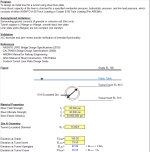Tunnel Design - Initial Support with Steel Liner Plate

Description
Purpose of calculation
- To design an initial liner for a tunnel using steel liner plate.
- Hoop thrust capacity of the liner is checked for a specified overburden pressure, hydrostatic pressure, and live load pressure, which consists of either AASHTO H-20 Truck Loading or Cooper E-80 Train Loading (Per AREMA).
Assumptions/Limitations and Conventions - Surrounding ground consists of granular or cohesive soil (Not rock)
- Tunnel support is 2-flange or 4-flange, smooth-back liner plate.
- Liner plate joints (flanges) are non-compact (not slender)
Calculation Reference - AASHTO LRFD Bridge Design Specifications (2010)
- CALTRANS Bridge Design Specifications (2000)
- AREMA Manual for Railway Engineering
- AISC Manual of Steel Construction, 13th Edition
- Contech Tunnel Liner Plate Design Guide
-------------------
CHANGE LOG
-------------------
VERSION 1.1
-Cleaned up figures and added validation.Calculation Reference
Tunnel Design
Tunnel Liner
Structural Design of Tunnels
Designing a tunnel with initial support using a steel liner plate is a complex process that involves various considerations such as ground conditions, loading conditions, and design methods. Here, I will provide an overview of the design process using the references you provided.
-
Site investigation and ground conditions: A thorough site investigation should be conducted to gather information about the geotechnical and geological conditions of the area. The investigation should include soil and rock sampling, in-situ testing, and laboratory tests to determine the soil/rock properties such as strength, stiffness, and permeability.
-
Tunnel geometry and loading conditions: Determine the tunnel geometry, including the size and shape of the cross-section, and establish the loading conditions. Loading conditions may include dead loads (soil and groundwater pressure), live loads (traffic or railway), and other loads such as seismic loads, depending on the location and purpose of the tunnel.
-
Design methodology: AASHTO LRFD Bridge Design Specifications (2010) and CALTRANS Bridge Design Specifications (2000) provide guidance on the design methodology for tunnels. The choice of the design method depends on the ground conditions, tunnel geometry, and loading conditions. Common design methods include the empirical method, the observational method, and the numerical analysis method.
-
Steel liner plate selection and design: The AREMA Manual for Railway Engineering and AISC Manual of Steel Construction, 13th Edition, provide guidelines for selecting and designing steel liner plates for tunnels. The steel liner plates should be designed to withstand the applied loads and provide initial support to the surrounding ground. The design should consider factors such as plate thickness, size and shape of the liner plate, and the required connection details.
-
Structural analysis and design: Perform a structural analysis to evaluate the performance of the steel liner plate under the applied loads. The analysis can be done using analytical methods or numerical methods such as finite element analysis. The analysis should consider factors such as the interaction between the liner plate and the surrounding ground, the effect of ground support systems (e.g., rock bolts, shotcrete), and the effect of construction sequence.
-
Construction considerations: Plan the construction sequence and method based on the tunnel design and ground conditions. The Contech Tunnel Liner Plate Design Guide provides guidance on the installation of steel liner plates in tunnels.
-
Inspection and maintenance: Develop a regular inspection and maintenance program to ensure the long-term performance of the tunnel and its steel liner plate. Inspections should include visual examinations, measurements of deformation and displacement, and corrosion assessments.
In conclusion, designing a tunnel with initial support using steel liner plates requires a thorough understanding of the ground conditions, loading conditions, and design methodology. The references you provided are excellent resources for designing such tunnels, and by following the guidelines in these references, a safe and effective tunnel design can be achieved.
Calculation Preview
Full download access to any calculation is available to users with a paid or awarded subscription (XLC Pro).
Subscriptions are free to contributors to the site, alternatively they can be purchased.
Click here for information on subscriptions.






